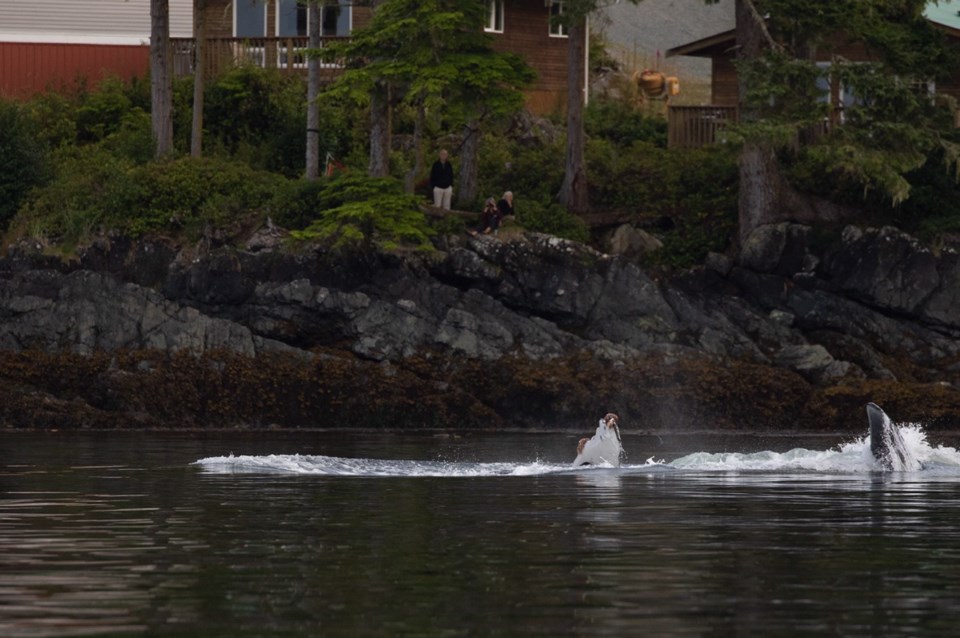The celebrated reappearance of a young humpback whale nicknamed Poseidon on the north Island has researchers reminding boaters to take extra caution when heading out on the water this summer.
Humpbacks are still making a comeback from near extinction and their unpredictable feeding habits and acrobatic breaching can put both whale and boater in danger, said Jackie Hildering, a humpback researcher and educator with the Marine Education and Research Society, based in Port McNeill.
Data collected from 2004 to 2006, the latest available, indicates there are at least 2,145 adult humpbacks around inshore waters of the North Pacific, but Hildering said a more comprehensive survey now underway expects to count many more, as the giant creatures — some as big as a transit bus — continue to make a comeback.
Last year, close to 100 humpbacks were feeding and swimming off northeast Vancouver Island, a sharp increase from seven in 2003.
This year, that group includes Poseidon, who on Friday was feeding near Telegraph Cove.
As a yearling last year, the whale was spotted with its mother at Port Alice, where students at a local school chose the name for the trident-like markings on its tail fin.
Hildering said the Marine Education and Research Society wants to see more of whales like Poseidon, who are returning to the same areas every year to feed during their migrations to Mexico and Hawaii.
The society’s “See a Blow, Go Slow” campaign educates boaters on safety while sharing the waters with humpbacks.
“Humpbacks are not like orcas. They don’t often swim in [straight] lines or have bio-sonar to find their food. Humpbacks are much more unpredictable,” Hildering said.
She said humpbacks are often “lunge feeders,” meaning they sometimes lurch up from the depths to capture krill or balls of herring. They can be suddenly very acrobatic and breach, often unaware there is a boat nearby.
They also feed on the surface by creating bubble nets to surround and then gobble their prey. Birds feeding on krill, plankton or herring are often a good indicator that a humpback could be in the area as well, Hildering said.
“We can’t put humpback-crossing signs across our coast, but we are trying to get the awareness out that these whales don’t often know a boat is around,” she said. “Sooner or later, someone will die if a whale is hit at full speed.”
A Washington state ferry struck a humpback on July 6 near Whidbey Island. The whale was presumed killed. It followed an incident in May 2019 when a different state ferry on the Seattle-Bainbridge Island route struck and killed another humpback.
Three people were taken to hospital in Alaska on June 29 when a humpback unexpectedly breached in front of a pleasure boat.
In 2017, a B.C. man was left a paraplegic after a guided fishing boat collided with a breaching humpback just outside Naden Harbour on Haida Gwaii. Two years before that, a Calgary woman vacationing in Mexico was killed when a breaching whale landed on a tour boat. And in 2013, a man was seriously injured when his boat collided with a humpback whale off the B.C. coast. He underwent extensive facial reconstructive surgery.
Hildering said humpback crashes are tragic for both sides, and rarely reveal damages to the whales involved.
She said whales that are not severely cut most likely have internal bleeding and either sink to the bottom or wash up on shorelines many months later, when scientists have no way of telling how the creature died.
“We just don’t know how often whales are dying” from human interaction, she said.
Entanglements with fishing lines and ropes are also common. Hildering said about half the whales documented off the B.C. coast show signs of scars from entanglements.
The migration of the humpbacks to warmer climates for birthing is continual and staggered, said Hildering, noting the big mammals can be seen around the Island in nearly every month of the year.
She said research has shown that the majority of humpback whales documented off northern Vancouver Island to the north coast migrate to Hawaii. For the humpbacks documented off southern B.C., half were found to migrate to Mexico, about a third migrated to Hawaii, and a few were found to migrate as far as Central America.
“But it has also been found that sometimes humpbacks will migrate to more than one area,” Hildering said. For example, a mature male nicknamed Stripe has been documented in both Mexico and Hawaii.
Hildering said researchers see mating-related behaviour in British Columbia as well, such as males singing and engaging in competitive interaction, more often later in the season.



